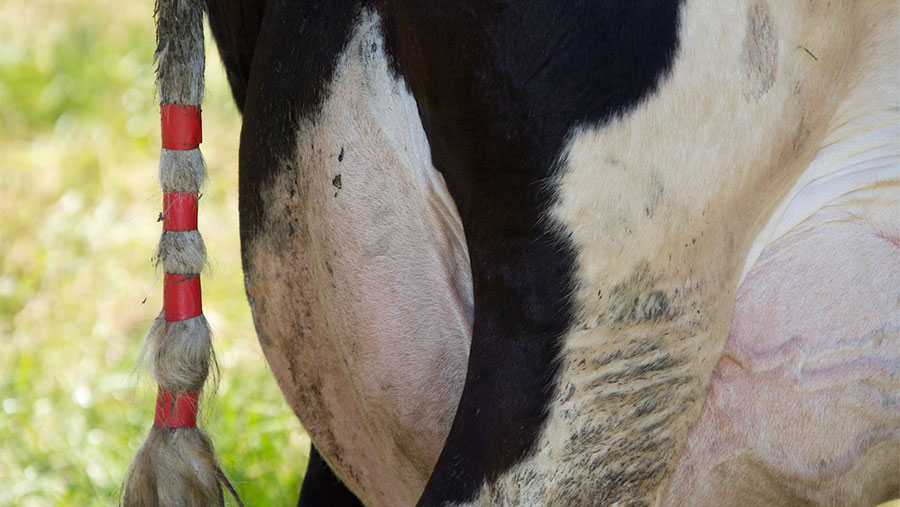New progress tracker helps in fight against Johne’s
 Tape in a dairy cow's tail © Tim Scrivener
Tape in a dairy cow's tail © Tim Scrivener A new tool for interpreting Johne’s disease test results has been developed to help farmers make informed decisions about how to control the chronic and irreversible condition in their herds.
The Johne’s Progress Tracker compares an individual farm’s data with benchmarks that have a significant impact on infection rates.
It provides a common framework for presenting test results so that farmers can see more easily the effectiveness of the disease management strategies they are using.
See also: Johne’s in cattle: How to prevent and manage the disease
“We are including the top 25% level and the average for each parameter,” says Peter Orpin, dairy vet and chair of the Johne’s technical group.
“Comparing these key parameters with individual herds will highlight where a herd’s strengths and weaknesses are in terms of Johne’s control.”
The tracker was developed to be shared freely with milk recording organisations and any laboratories and software companies in the UK wishing to use it.
So far, it is available to all users of National Milk Records’ (NMR) Interherd+, NMR’s Herdwise Johne’s screening service and the Cattle Information Service (CIS) YourHerd online portal.
Tracker design
The tracker measures four key drivers of the disease at herd level: progression (new infections), removals, disease pressure and persistence.
The benchmarks were identified from data analysis carried out by the University of Reading.
A pilot involving 39 herds known to three veterinary practices was followed by widescale testing on more than 50,000 cows in a total of 257 randomly selected herds where quarterly, whole herd milk testing was being carried out.
How the tracker works
The level of disease is indicated by two measures.
The first is average test value (ATV), which is the mean of all individual Johne’s quarterly milk test results, providing an indication of the number of highly test-positive animals, and the severity of the disease.
The second is the percentage of cows testing positive.
The Johne’s Tracker takes historic test results, along with other herd data, and provides a simple colour-coded representation to give a clear picture of disease progression within and between herds.
The progress tracker table shows herds with the highest prevalence in pink, followed by yellow, then light green. The herds with the lowest prevalence are dark green.
Tracking improvement
Once transmission from cow to calf has been blocked, it takes two to three years for the benefits to filter through, and five to seven years of improvement in all four outcomes to move from pink to green on the tracker.
Dr Orpin cautioned that testing is not perfect and that creating a low-risk environment where hygiene is a central plank of control is key.
Funding for the Johne’s Tracker was provided by AHDB and Dairy UK.
Johne’s disease – the basics
Johne’s disease is caused by infection with Mycobacterium avium subspecies paratuberculosis (Map). Clinical cases of Johne’s disease are just the tip of the iceberg.
Sources of infection
- Animals are usually infected as calves
- Infection is mainly by ingesting faeces from contaminated bedding, udders and buckets, or from colostrum or milk
- Infection occurs much less commonly in the womb or later in life
- Infected animals will test negative, usually for several years, before the disease progresses. This is due to the way a young animal’s immune system responds to the bacteria
- Infection is almost always introduced to a herd by bringing in infected replacement breeding stock
- Importing slurry and swapping colostrum between herds also risks spread of infection
Impact on affected animals
- Cows testing positive are twice as likely to have a cell count >200,000 cells/ml and milk yields 25% below their adjusted herd average
Costs to the farm business
- Disease costs can rise to 1-2p/litre or more with higher disease incidence and last for a number of years before the disease is brought under control
- Major costs come from increased susceptibility to other conditions, increased forced culling and keeping cows that should otherwise be culled
Source: Action Group of Johne’s
